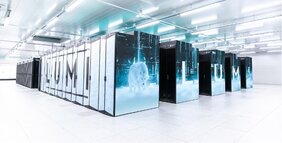A Swiss-German research team hopes to unlock the secrets of star formation using Europe’s fastest computer – the LUMI-G supercomputer in Kajaani (Finland) run by an international consortium. The researchers have received computing time on the LUMI-G for the required simulations, which will also utilise a newly developed simulation code. Also Heidelberg astrophysicists are contributors to the research. Project partner Prof. Dr Ralf Klessen of Heidelberg University’s Centre for Astronomy (ZAH) also anticipates groundbreaking insights for his own research.
In particular, the researchers aim to simulate the behaviour of gases and plasmas to gain a better understanding of star formation. Among other things, they can track the mass distribution of stars – processes that in turn influence the development of entire galaxies. A new simulation code called SPH-EXA will be used. Interstellar turbulences can be modelled in conjunction with the spatial resolution achievable with the twelve-month computing power of the LUMI-G. The resulting findings are key to a deeper understanding of turbulent processes.
Prof. Klessen, a scientist at the Institute of Theoretical Astrophysics of the ZAH and an internationally recognised expert on hydrodynamic simulations on supercomputers, stresses: “With our simulations we are pursuing an approach that takes the particles of gases and plasmas into account to describe the movement of fluid elements in space. This allows us to make statements about the chaotic behaviour of turbulent streams or to better capture aspects of the transition from orderly to chaotic phases of the stream”. The computer experiment thereby opens up new avenues to better understand the formation of stars and star clusters in the turbulent multi-phase interstellar medium of galaxies such as our Milky Way.
The interdisciplinary research team led by scientists from the universities of Zürich and Basel is also involved in the international Square Kilometre Array Observatory (SKAO), the world’s largest and most sensitive radio observatory currently under construction. The simulation data generated by LUMI-G will also be used to develop software that can filter out and interpret special signals from SKAO telescope data.
ABOUT RALF KLESSEN
Ralf Klessen has been a professor at the Institute of Theoretical Astrophysics, which is part of the Centre for Astronomy of Heidelberg University, since 2006. Among other things, he and his research team study various aspects of star formation in the Milky Way and the early universe as well as the origin of cosmic magnetic fields. Because this work relies heavily on computer simulations, the team is also focussed on the development and improvement of numerical algorithms.
FURTHER INFORMATION
University of Heidelberg Press Release - https://www.uni-heidelberg.de/en/newsroom/european-supercomputer-aids-heidelberg-astrophysics
Ralf Klessen research group – www.ita.uni-heidelberg.de/research/klessen/index.shtml?lang=en
LUMI-G-Supercomputer – www.lumi-supercomputer.eu
Square Kilometre Array Observatory – www.skao.int
CONTACT FOR THE MEDIA
Dr. Guido Thimm
Center for Astronomy of Heidelberg University
thimm@uni-heidelberg.de

